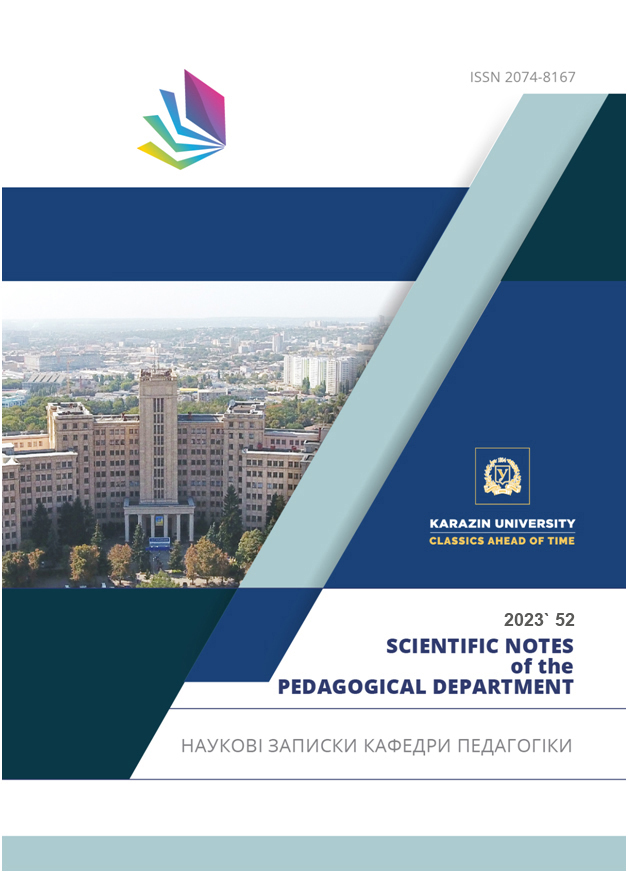Умови ефективної соціальної взаємодії учнів молодших класів при дистанційному навчанні
Анотація
Розвиток навичок соціальної взаємодії є важливим у молодшому шкільному віці, оскільки вміння співпрацювати, спілкуватися, контролювати та виражати власні почуття, йти на компроміси, долати труднощі тощо є запорукою для подальшої реалізації особистості в житті. На жаль, за сучасних реалій, зважаючи на воєнний стан, молодші школярі більшості з регіонів України не мають можливості перебувати в щоденному "живому" спілкуванні з однолітками й вчителями, де активно розвиваються навички соціальної взаємодії. Дистанційний формат навчання з онлайн-уроками спричиняється до низки педагогічних та психологічних проблем, пов'язаних зі зниженням ефективності взаємодії між вчителем та учнями, учнями між собою, що негативно впливає на розвиток навичок соціальної взаємодії. За цього контексту виникають нові виклики для педагогів (а також і для батьків).
Завантаження
Посилання
Honcharenko, O.S. (2016). Development of social responsibility of junior high school students in distance learning conditions. Bulletin of Kharkiv National Pedagogical University named after H. S. Skovoroda, Vol. 49, 39-45. [in Ukrainian].
Honcharenko, O.S. (2019). Socio-psychological aspects of the development of social responsibility of junior high school students in the conditions of distance learning. Scientific notes of the Department of Pedagogy, Vol. 44, 17-23. [in Ukrainian].
Honcharenko, O.S. (2017). Formation of social responsibility of younger schoolchildren through projects of the
educational process. Pedagogy and psychology, 20-28. [in Ukrainian].
Goncharenko, O.S. (2014). Psychological-pedagogical foundations of the formation of social responsibility of students of junior grades in the conditions of the development of the information society. Pedagogy and psychology, 35-42. [in Ukrainian].
Kononenko, A.O. (2010). Pedagogy of creativity: educational and methodological manual. Kyiv: Academy. 192 p. [in Ukrainian].
Kononenko, A.O. (2005). Development of students’ creative abilities: theory and practice. Kyiv: Lybid. 320 p. [in Ukrainian].
Kononenko, A.O. (2016). Formation of students’ motivation to study: theory and practice. Kyiv: Slovo Publishing House. 368 p. [in Ukrainian].
Lysenko, M. I., & Lykhovyd, O. V. (2020). The effectiveness of using interactive technologies in mathematics lessons during distance learning. Information technologies and teaching aids. Vol. 77(4), 86-101. [in Ukrainian]. 9. Pityuk, A. (2021). Social interaction in online learning: reality and possibilities Scientific notes of the Ukrainian Academy of Sciences. Pedagogical sciences. No. 233. P. 92-98. [in Ukrainian].
Anderson, T. (2013). Social Interaction in Self-Paced Distance Education. The International Review of Research in Open and Distributed Learning, Vol. 14(4), 1-13. doi: 10.19173/irrodl.v14i4.1536.
Barbour, M. K., & Reeves, T. C. (2015). Online Learning and Teaching in K-12 Settings: A Review of Open Access Literature. The International Review of Research in Open and Distributed Learning. 16(1), 133-156. DOI: 10.19173/irrodl.v16i1.1925.
Cawthon, S., & Garberoglio, C. L. (2013). The Importance of Interaction for Academic Success in Online Courses with Hearing, Deaf, and Hard-of-Hearing Students. American Annals of the Deaf. 158(4), 357-368. DOI: 10.1353/ aad.2013.0042.
Juwah, C., MacCallum, K., & Lai, M. (2011). Facilitating Social Presence in Online Learning: Interaction Affordances and Cognitive Antecedents. Australasian Journal of Educational Technolog. 27(1), 1-15. DOI: 10.14742/ajet.939 14. Lesht, F., & Warschauer, M. (2012). Creating Effective Collaborative Learning Groups in an Online Environment. International Journal of Educational Technology in Higher Education. 9(1), 26-39. DOI: 10.7238/rusc.v9i1.1172. 15. Mannen, R. A., & Robinson, S. L. (2018). Social Interaction and the Role of Technology in Distance Learning. Journal of Online Learning Research. 4(1), 1-22. DOI: 10.1016/j.jalr.2018.01.001.
Matteson, M.L., Anderson, L., Boyden, C. (2016). Soft Skills: A Phase in Search of Meaning. Portal: Libraries and the Academy. Vol. 16. No. 1. P. 71-88.
Price, D. (2015). Soft skills are critical for success but what are they? Cambridge University Press. October 22. https://www.cambridge.org/elt/blog/2015/10/22/5-easy-ways-to-integrate-soft-skills-in-your-class . 18. Raciti, P. (2015). The measurement of transversal competences in Colombia: a methodological proposal. URL: http://sia.eurosocial-ii.eu/βiles/docs/1444897404-DT34.pdf.
Richardson, J. C., & Swan, K. (2014). Social Interactions in Online Education: A Review and Synthesis. In A. A. Juan & M. Daradoumis (Eds.), Assessing the Role of Mobile Technologies and Distance Learning in Higher Education (pp. 75-102). IGI Global. DOI: 10.4018/978-1-4666-6066-9.ch005.
Rourke, L. M., & Anderson, T. (2004). Synchronous and asynchronous communication in distance learning:
A review of the literature. Quarterly review of distance education, 5(1), 1-16.
Shek, D. T., Leung, J. T., Merrick, J. (2017). Paradigm shift in youth development: Development of “soft skills” in adolescents. International Journal on Disability and Human Development, 16(4), 337-338. doi:10.1515/ ijdhd-2017-7001.
Simon, N. A., & Starling, D. D. (2019). Best practices in online teaching strategies for K-12 teachers. International Journal of Information and Learning Technology, 36(1), 2-13, DOI: 10.1108/IJILT-09-2018-0095.
The Future of Jobs Employment, Skills and Workforce Strategy for the Fourth Industrial Revolution. World Economic Forum. URL: http://reports.weforum.org/future-of-jobs-2016/.
The Future of Jobs. Report 2020. URL: http://www3.weforum.org/docs/WEF_Future_of_Jobs_2020.pdf.

